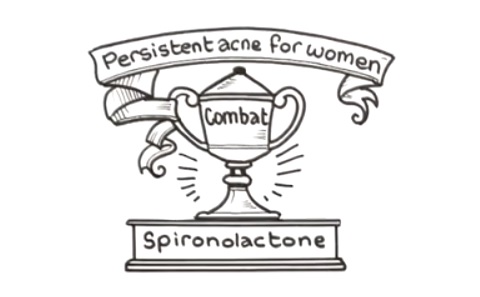Blog: What do we know about prescribing spironolactone for acne?

The results of the SAFA study have shown that spironolactone, a cheap and readily available drug used to treat high blood pressure, could be an effective, non-antibiotic treatment for the thousands of women who suffer from persistent acne.
But questions remain about the drug and prescription of it.
In an opinion piece for the British Medical Journal, SAFA Chief Investigators Professor Miriam Santer and Professor Alison Layton discuss some of the questions GPs may have about prescribing spironolactone for acne.
Recurrent acne can have a negative psychosocial impact in adolescence, which can persist into adulthood. Topical treatments are recommended as first line by guidelines, but many people with acne are treated with extended courses of antibiotics, which should be prescribed alongside topical treatments, although are often prescribed on their own. Spironolactone may be a useful alternative to oral antibiotics for women with persistent acne.
Our experiences of prescribing spironolactone for acne differ. Alison, a dermatologist, has prescribed it successfully for acne over the past 20 years on the basis of clinical experience, case series, and very small trials.1 Miriam, a GP, has never prescribed spironolactone for acne, but has often prescribed it for cardiovascular conditions. Following evidence from this trial (https://www.bmj.com/content/381/bmj-2022-074349), Miriam will prescribe it for persistent acne in women too, as may other GPs. However, GPs are likely to have questions regarding prescribing spironolactone for women with acne.
One question is, when might spironolactone be appropriate for women with acne? Topical preparations are effective first line treatments for acne,234 but it is not unusual for people to experience adherence issues to topical therapies or find them only partially effective.5 Prescribing prolonged courses of oral antibiotics for acne remains common.6 But acne guidelines recommend limiting treatment with oral antibiotics to three to six months to avoid the emergence of antimicrobial resistance.234 Clinicians report barriers to discontinuing oral antibiotics once they have been started,7 including patient reluctance to stop treatment and frequent acne relapses.
Our research shows that, for women with acne that persists despite topical treatment, prescribing oral spironolactone alongside topical treatment has the potential to significantly reduce long term oral antibiotic prescribing.
Another question GPs have asked us is about spironolactone and pregnancy. Although spironolactone is cautioned against in pregnancy, it is less teratogenic than oral tetracyclines,8 which are commonly used for acne in young women.9 We suggest it is appropriate that in usual practice spironolactone be treated with no special restriction beyond contraceptive counselling, as is the case for oral tetracyclines.
We have also been asked about monitoring renal function and potassium levels for women with acne prescribed spironolactone. A baseline check of renal function and potassium levels is advisable prior to commencing spironolactone for acne in order to exclude renal impairment.3 However, ongoing monitoring is unnecessary for most young women,3 and has recently been advocated only in women over 45 or with relevant comorbidities.10
Finally, GPs have asked us about dosing of spironolactone for acne. Our findings on tolerability suggest it may be pragmatic to initiate spironolactone treatment at 50 mg and, if tolerated, escalate the dose to 100 mg within one or two weeks. It is possible that this approach would lead to spironolactone becoming effective faster, given that this study demonstrated better response at six months than at three.
Unfortunately, spironolactone is not considered an acceptable treatment option for men with acne. Use of spironolactone reduces blood testosterone levels which can result in gynaecomastia (breast swelling),11 and concerns have been raised about loss of sexual function in men.
Spironolactone may therefore be a welcome therapeutic option for women with persistent acne. Anecdotally, many women invited to participate in the study told us that they had already heard of spironolactone via social media and were keen to try it. They shared the huge impact that acne has had on their self-esteem and the importance of having a drug available that avoids some of the side effects of other therapeutic options. Spironolactone may provide an effective alternative to antibiotics that avoids emergence of antibiotic resistance and provides a longer term solution than antibiotics to women with persistent acne. Questions remain about starting dose, relative effectiveness in comparison with other treatments, and which subgroups benefit most from spironolactone. Some of these questions will be answered in ongoing trials. It is also hoped that further understanding of the mechanism of action of spironolactone may lead to new treatment options, for men as well as for women.
>> See the full opinon piece here.
You can also read our news story on the SAFA results including a video interview with a SAFA study participant, watch a video infographic about the SAFA study, and read the full SAFA results publication in the British Medical Journal.